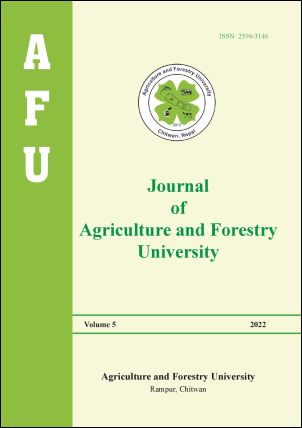Understanding the role of key determinants towards realizing food insecurity amongst the rural households: A case from Bajhang and Morang districts of Nepal
DOI:
https://doi.org/10.3126/jafu.v5i1.48472Keywords:
Food security, MPI, HFIAS, LogitAbstract
Food insecurity is one of the single largest determinants to challenge Nepal from realizing its ambition of graduating to a developing country. In line with the imminent national challenge, this study has tried to delve into the real-time findings from the rural part of the country to understand the crucial determinants of food insecurity. A household (HH) level survey with a sample size of 502 was adjudged using Krejcie and Morgan (1970) method. Semi-structured HH survey was administered to collect the socio-economic status of the respondent. Household Food Insecurity Access scale (HFIAS) was used to assess HHs food insecurity, whereas poverty status was assessed using the multidimensional poverty index (MPI). Finally, to identify the determinants of food security binary logistic regression technique was used. The MPI adjudges the aggregate status as 21%, 30.6% in Bajhang, and 14% for Morang. HFIAS tool unveiled that 47% HH were food secure. The disaggregated figure stands as 46% and 48% of households being food secure in Bajhang and Morang districts, respectively. Among the surveyed households, half of the households expressed food insecurity as the greatest concern and the consequential uncertainty ahead. The assessment further found that the Per Capita Income score (p<.01), access to financial institutions (cooperative) (p<0.01), holding livestock (p<.05), and expenditure on food (p<0.01) have a positive relationship in the case of Bajhang household. On the other hand, wage labor (p<0.01) earning members in the village (only for Morang), MPI poor (p<0.05) HHs and abroad migration (p<0.05) (only for Bajhang), ethnic cast Dalit (for both) (p<.05) had a significant negative relationship on household food security.
Downloads
Downloads
Published
How to Cite
Issue
Section
License
Copyright (c) 2022 Agriculture and Forestry University (AFU), Rampur, Chitwan, Nepal

This work is licensed under a Creative Commons Attribution-NonCommercial 4.0 International License.
This license allows reusers to distribute, remix, adapt, and build upon the material in any medium or format for noncommercial purposes only, and only so long as attribution is given to the creator.




